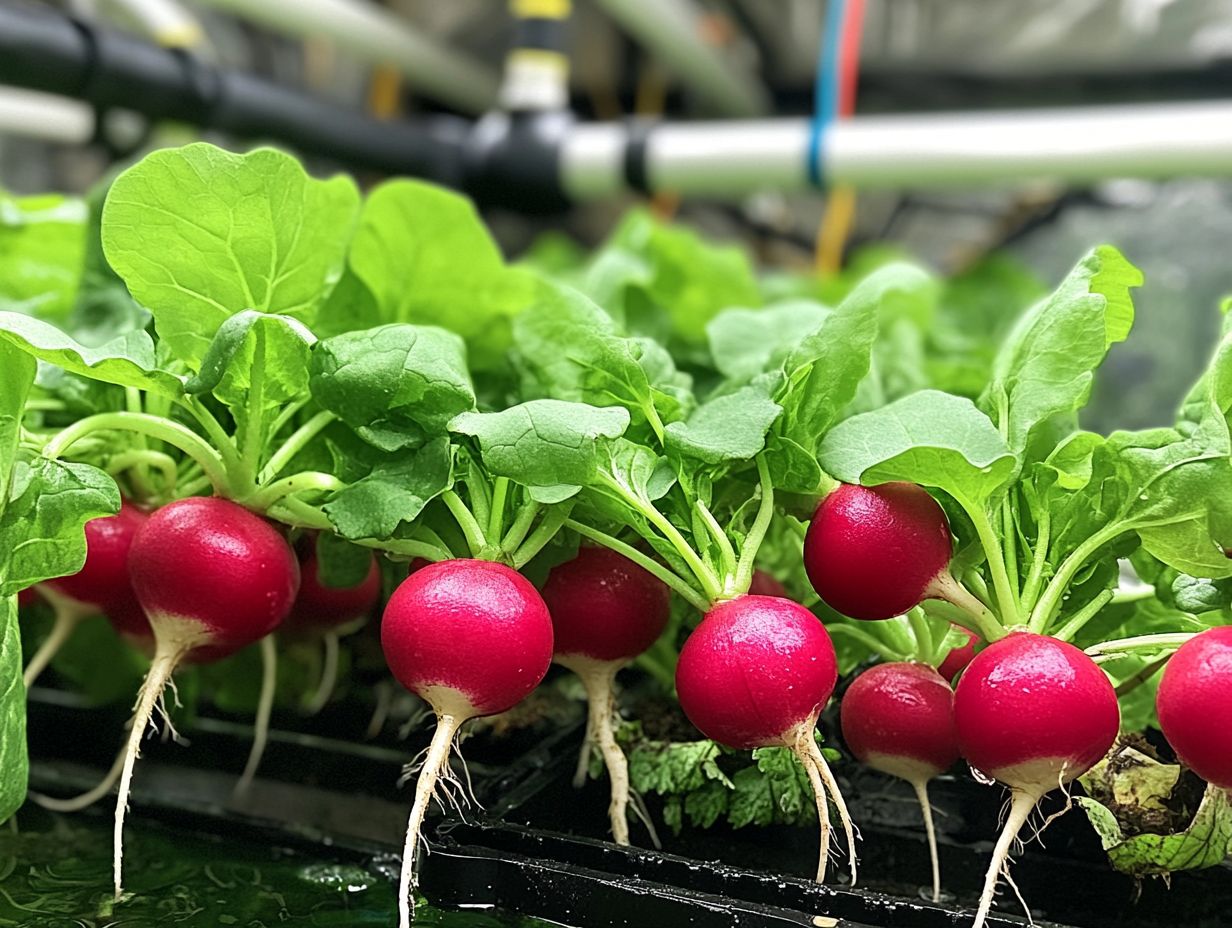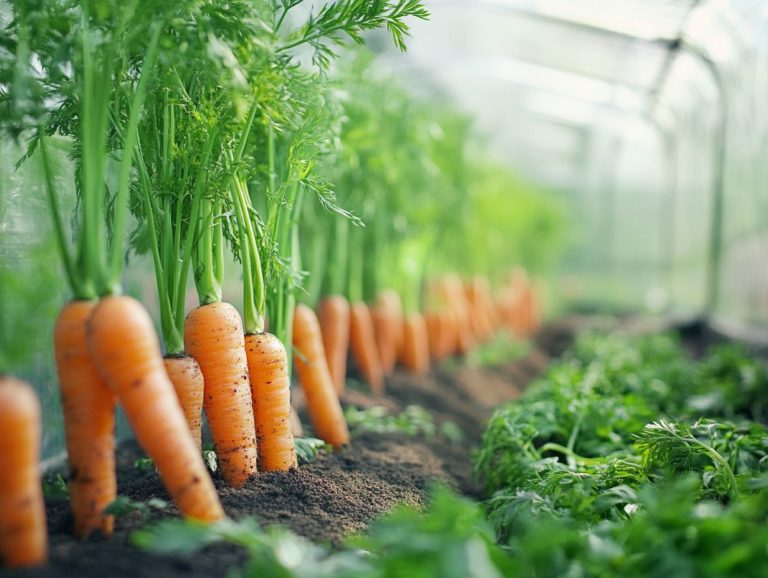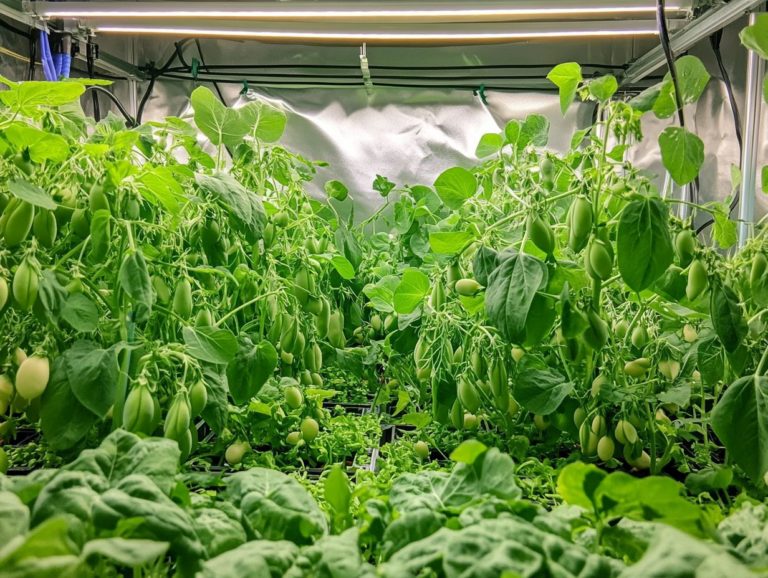“How to Grow Hydroponic Radishes Easily”
Are you intrigued by the idea of growing radishes without soil? Hydroponic radishes offer an exceptional way to savor fresh, crisp vegetables right in the comfort of your home, all while maximizing space and minimizing effort.
This article explores the many benefits of hydroponic gardening, outlines the essential supplies you’ll need, and provides a comprehensive, step-by-step guide to cultivating your own delightful radishes.
You will also discover expert tips on harvesting and storing to ensure optimal flavor and freshness. Get ready to dive into this exciting journey of growing your own radishes!
Contents
Key Takeaways:

- Hydroponic radishes are a type of plant that can be grown without soil, using only water and nutrients.
- Growing hydroponic radishes has many benefits, including faster growth, higher yields, and less mess compared to traditional gardening.
- To grow hydroponic radishes, you will need some basic supplies and equipment, such as a growing tray, nutrient solution, and seeds.
What are Hydroponic Radishes?
Hydroponic radishes are a captivating category of root vegetables, cultivated in a soilless environment with nutrient-rich water solutions. These quick-growing edibles, including popular varieties like Cherry Belle and French Breakfast, flourish in controlled settings. Here, you can optimize factors such as pH levels, temperature, and light sources.
Using a hydroponic system like deep water culture (DWC) allows for a sustainable harvest of these crunchy delights while sidestepping the common pitfalls of soil-borne diseases.
Apart from their impressive growth rate, these radishes bring a host of advantages over traditional soil gardening. The absence of soil not only diminishes the threat of pests and diseases but also enables a more efficient utilization of water and nutrients. This means less waste and ensures your plants receive exactly what they need for peak growth.
With a variety of options, such as the spicy Daikon and the vibrant Watermelon radish, each type offers unique flavors and nutritional benefits, elevating your culinary possibilities. Germination is a breeze, with seeds sprouting in just a few days, leading to quicker harvests overall.
This highly efficient system is appealing to both novice gardeners and seasoned horticulturists eager to broaden their gardening horizons.
Benefits of Growing Hydroponic Radishes
Growing hydroponic radishes presents a wealth of advantages, especially for those keen on upholding a healthy diet while conserving space and resources. Cultivated through hydroponics, these root vegetables become a healthy option that not only aids in maintaining healthy blood sugar levels but also delivers essential vitamins like Vitamin C, making them the perfect healthy snack.
Furthermore, by meticulously managing nutrient levels, temperature control, and humidity levels, you can create optimal conditions for vigorous growth, effectively minimizing common issues like root rot and yellowing leaves.
Advantages over Traditional Gardening
The advantages of hydroponic gardening over traditional methods are abundant, especially when it comes to the health and efficiency of the plants you re nurturing. Hydroponic systems utilize nutrient solutions, effectively eliminating the risk of soil-borne diseases and fostering healthier plants with fewer pests.
By controlling the light source and other environmental variables, you can create optimized growth conditions. This makes hydroponics an appealing choice whether you’re a novice gardener or a seasoned pro.
Along with these advantages, hydroponic gardening drastically reduces water usage compared to conventional practices, as these systems cycle water and minimize waste. This eco-friendly approach also promotes space efficiency, allowing you to grow plants vertically and thrive in urban settings where land is at a premium.
The absence of soil not only frees you from the hassles of traditional pests but also eliminates the need for harmful pesticides, resulting in cleaner and safer produce for consumers. When you consider all these factors, it becomes clear that hydroponics presents a compelling alternative to soil-based gardening, especially in regions grappling with water scarcity or urbanization challenges.
Supplies and Equipment Needed

To successfully cultivate hydroponic radishes, you must first gather the right supplies and equipment specifically designed for hydroponics gardening.
Essential items include hydroponic systems like DWC (Deep Water Culture), a method where plants’ roots are submerged in oxygen-rich nutrient solution, or the Nutrient Film Technique, along with vital tools such as pH meters, nutrient solutions, and top-notch growing mediums like Rockwool that facilitate optimal germination.
Consider using systems like iHarvest and uHarvest to streamline the process, offering an efficient means to monitor and manage the intricate needs of your indoor garden.
Essential Tools and Materials
Essential tools and materials for your hydroponics gardening journey include equipment designed to monitor and maintain the right nutrient levels and environmental conditions. You’ll find that tools like pH testers, EC meters, and humidity gauges are critical for successful cultivation.
Pruning radishes is important for keeping your plants healthy, promoting growth, and ensuring a bountiful harvest.
Each of these tools serves a distinct function. For example, pH testers enable you to measure acidity or alkalinity, ensuring your plants can absorb nutrients effectively. EC meters measure the electrical conductivity of your nutrient solution, indicating its concentration and helping you achieve the perfect balance for plant uptake.
Humidity gauges are essential for monitoring moisture levels in the air, helping you avoid conditions that could lead to mold or pest issues.
By using the right nutrient solutions tailored to your plants’ specific needs, you provide essential minerals. Selecting appropriate growing mediums like coco coir or Rockwool supports root stability and aeration, further enhancing the overall growth process.
Step-by-Step Guide to Growing Hydroponic Radishes
To successfully cultivate hydroponic radishes, you need to follow a systematic, step-by-step guide that highlights the importance of crafting an optimal environment and employing the right hydroponic system.
- Start by selecting the radish variety that appeals to you.
- Prepare your growing medium to ensure it s suitable for hydroponic success.
- Focus on germination by placing your seeds thoughtfully in the nutrient solution.
- Ensure you provide adequate light sources to foster growth.
As you proceed, it s essential to adjust pH levels and maintain nutrient concentrations, as these factors are critical for a thriving hydroponic garden.
Preparing the Growing Environment
Let s get your growing environment ready for amazing radishes! Preparing the growing environment is crucial for cultivating hydroponic radishes, as it lays the groundwork for vibrant growth and optimal yields.
This preparation involves selecting the right growing medium to support the root structure, ensuring pH levels hover between 5.5 and 6.5, and maintaining the ideal temperature and humidity that promote germination and growth.
By fine-tuning these elements, you can create a nurturing atmosphere where your radish plants thrive. The growing medium you choose be it coconut coir, perlite, or a specialized hydroponic blend plays a pivotal role in air retention and drainage, which directly impacts root health.
Regulating pH levels is crucial; an imbalance can hinder nutrient absorption, leading to stunted growth and disappointing yields. Temperature control is just as vital; radishes thrive in cooler environments, typically between 60 and 70 F. Keeping an eye on humidity levels is necessary to prevent mold and diseases.
Together, these factors establish an ideal microclimate that enhances the resilience and productivity of your radish crop.
Start growing your hydroponic radishes today and enjoy fresh produce right from your home!
Planting and Maintaining Radishes

Planting and maintaining radishes in a hydroponic system requires essential steps to secure a fruitful harvest. Start by sowing your radish seeds into the chosen growing medium. Make sure they are adequately covered to encourage germination.
Once they sprout, monitor the nutrient solution closely. Adjust concentrations as needed and provide ample light for vigorous growth. Regularly pruning your radishes may also be necessary to ensure their health. This helps remove unhealthy foliage and enhance air circulation.
For optimal results, pay careful attention to water pH levels. They significantly influence nutrient absorption and overall growing conditions. A consistent light schedule of about 12 to 16 hours per day mimics natural sunlight, vital for photosynthesis.
As your radishes flourish, keep an eye on their growth patterns. This will help you determine whether adjustments in light intensity or nutrient levels are warranted. Maintaining a place where you can control the temperature with conditions between 60 F and 70 F can positively impact the development of your radish crop.
With dedicated care, get ready for a fantastic reward! You ll enjoy a bountiful yield of crisp, flavorful radishes in just a few weeks, making them an excellent choice for a healthy snack.
Harvesting and Storing Hydroponic Radishes
Harvesting and storing hydroponic radishes is pivotal for maintaining the quality and freshness of your crop. Once the radish bulbs have achieved their optimal size usually reflected in their firm, crunchy texture harvest them carefully to prevent any damage to the plants.
Employing proper storage techniques is vital for preserving their flavor. You might also try pickling the radishes for extended preservation, offering a tangy twist to this delightful vegetable.
When and How to Harvest
Knowing when and how to harvest radishes is vital for ensuring they reach their peak flavor and crunch. Generally, you should plan to harvest radish bulbs when they measure 1-2 inches in diameter, depending on the variety, and exhibit that desirable firm, crunchy texture.
To harvest, gently pull the radish plants from the soil. Be careful not to harm the roots or any neighboring bulbs. This approach guarantees a clean and efficient harvest.
Timing is everything; most radish varieties will be ready for harvest within three to six weeks of planting. Monitor the size of the bulbs to make informed decisions about when to pull them. Don’t wait too long to harvest; the sooner you do, the better the taste! If you’re looking to elevate the flavor, consider harvesting during cooler parts of the day, such as early morning or late afternoon, as this can enhance their sweetness.
A gentle twisting motion as you pull can minimize damage, helping to preserve the health of the remaining plants in your garden.
Proper Storage Techniques
Proper storage techniques are essential for preserving the quality and freshness of your harvested radishes, particularly that delightful crunch. First, remove any excess dirt and trim the leaves to prevent decay.
After cleaning, consider placing your radishes in a perforated plastic bag to create a slightly humid environment, which they thrive in. For an extra boost in flavor and texture, wrap the radishes in a damp paper towel before putting them in the bag. This helps retain moisture without turning them soggy.
If you’re looking to store them for a longer period, think about using containers filled with slightly damp sand or a root cellar that provides cool, dark conditions. By following these methods, you ll be able to enjoy the crisp and peppery flavor of radishes for an extended time. They make a dependable ingredient for salads, garnishes, or any culinary adventures you embark on.
Frequently Asked Questions

Why Grow Hydroponic Radishes?
Hydroponic radishes grow without soil. Instead, they use nutrient-rich water. They’re easy to cultivate, save space, and yield more than traditional radishes!
What Materials Do I Need?
To start, gather a hydroponic system, nutrient solution, net cups, a tool to measure acidity or alkalinity in the water, grow lights, and radish seeds. You can find these at a local garden supply store or online!
How Long Does It Take to Grow Them?
Hydroponic radishes typically mature in 3-4 weeks. Your exact timing will depend on the radish variety and your growing conditions.
What’s the Best Temperature?
The best temperature is between 60-70 F. Maintaining a steady temperature boosts growth and quality!
Do I Need to Change the Nutrient Solution?
Change your nutrient solution every 1-2 weeks. This keeps your plants healthy and thriving!
Can I Reuse the Nutrient Solution?
Don t reuse the nutrient solution for other plants. It can get contaminated with bacteria from the radish roots, harming other plants.
Start your hydroponic garden today for fresh, crunchy radishes in just weeks!






